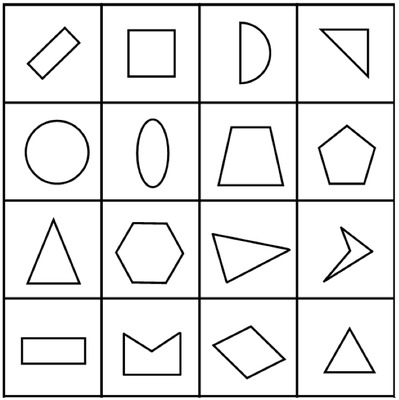Task
Materials:
This game uses the 16 cards below.

Actions:
Students in pairs take turns drawing two cards. They should name something that is the ALIKE or DIFFERENT between the two cards. Then the next two cards are drawn and the process repeats until no cards remain.
In a cooperative game, the students work together to name a property for each pair.
In a competitive game, the student who can name a property first gets to keep the cards and the student with the most cards at the end of the game wins. Since the properties may depend on the orientation of the cards, students should sit side-by-side in this version.
IM Commentary
If a more difficult game is desired the students can name two things that are alike or different.
Including blank cards allows students to draw their own shapes to add to the game.
The language students use will be informal, as is appropriate for kindergartners (ex: “This one is curvy and this one isn’t”; “This one has more corners”; “Both of them are pointy”).
Submitted to Jason Dyer to the fourth Illustrative Mathematics task writing contest.
The Standards for Mathematical Practice focus on the nature of the learning experiences by attending to the thinking processes and habits of mind that students need to develop in order to attain a deep and flexible understanding of mathematics. Certain tasks lend themselves to the demonstration of specific practices by students. The practices that are observable during exploration of a task depend on how instruction unfolds in the classroom. While it is possible that tasks may be connected to several practices, only one practice connection will be discussed in depth. Possible secondary practice connections may be discussed but not in the same degree of detail.
This particular task is linked very intentionally to the first part of Mathematical Practice Standard 3, construct viable arguments. Students work in pairs and take turns drawing two cards. These cards have pictures of different shapes. The students are asked to describe what is similar or different between the two shapes. This type of task lays the foundation for the art of explanation leading to “critiquing the reasoning of others.” Before students can critique the reasoning of others, they must feel comfortable in supporting their own thinking with evidence. For instance, a kindergartner might offer the explanation, “I know that the shape has straight sides and the second shape has one curvy.” The teacher can easily promote a classroom discussion on this argument by asking, “Do you agree and why?” This type of math talk in the classroom is built through collaborative problem solving and dialog.





